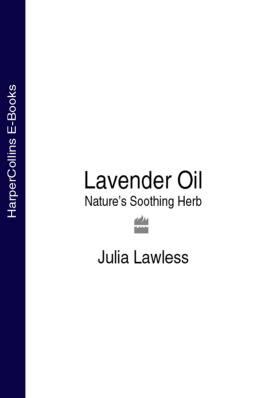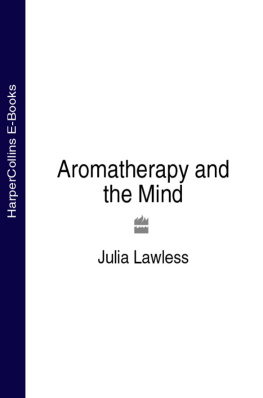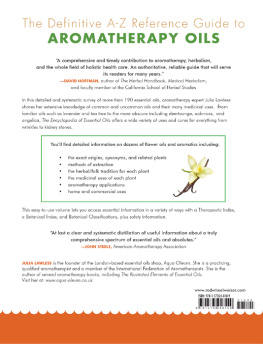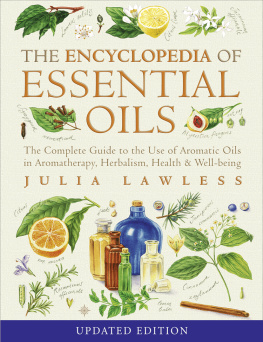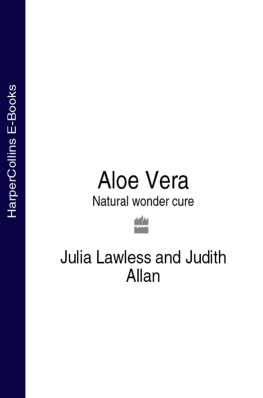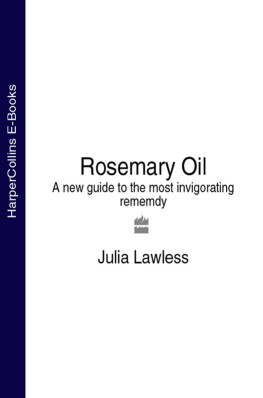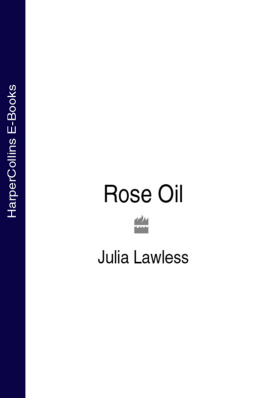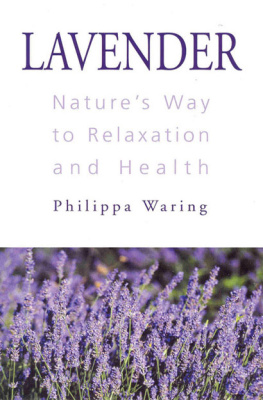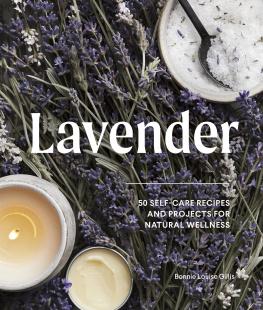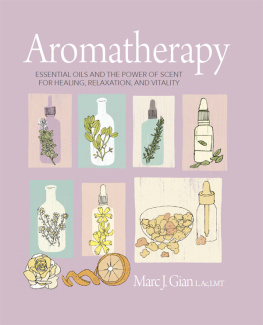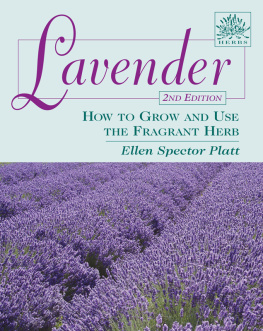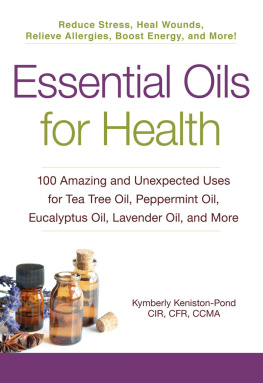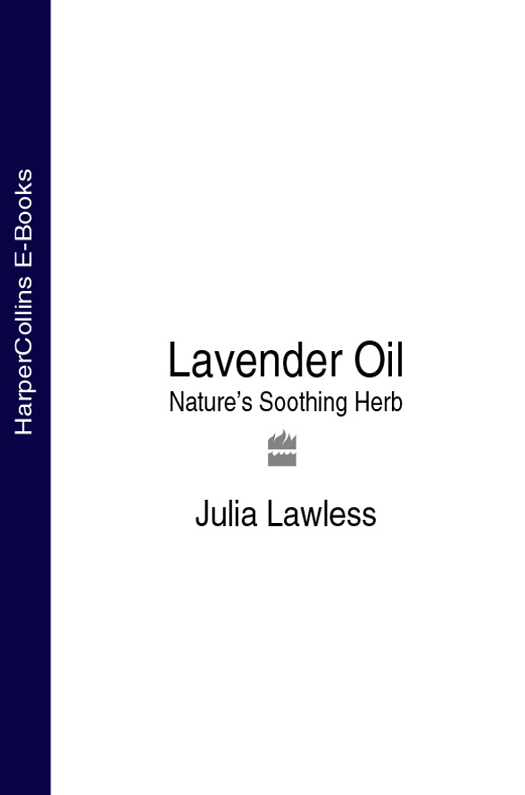Dedicated to
NATASHA
Contents
.
As I write, the lavender in my garden is just coming into full bloom. It is one of my favourite herbs: sturdy yet delicate, with a mass of hazy-purple flowers which suffuse the air with their dreamy-soft fragrance. I am also very fond of the essential oil of lavender, and use it more than any other oil about the house. It is ideal as a remedy for children, for the treatment of all sorts of minor ailments, and as a bath oil or room fragrance. This book is dedicated to my young daughter Natasha, who has a keen interest in all perfumes and loves the scent of lavender.
I would especially like to thank the following people, who have contributed in various ways to the completion of this book:
Steward Alcock for his excellent translations from the French; John Black for his expertise and for providing technical information; Cara Denman for her guidance; Jane Graham-Maw and those at Thorsons for their sympathetic approach to the project; Len Smith for his editorial comments; and my husband Alec for his ongoing support.
I would also like to thank Perfumer & Flavorist for their kind permission to reprint the table outlining the detailed constituents of lavender oil (see Appendix B).
Oh how happy I am not to be one of those ornamental flowers that decorate the border! Im not at risk of falling into uncouth hands and am sheltered from frivolous discourse.
Unlike my sisters, the plants, nature makes me grow far from streams, and I dont like cultivated gardens or land.
I am wild. Far from society, my sojourn is spent in deserts and solitude, for I dont like mixing with the crowd!
Free, I am free!
The Song of Lavender (La Chante de la Lavande)
The unique character or personality of lavender is evident from the words of this song, taken from A Thousand and One Nights. Originally a native of the Mediterranean region, growing at altitudes of up to 1,800 metres (nearly 6,000 feet) in the mountains of southern France, this beautiful yet tough and resilient plant has been cherished by all cultures alike, not only for its fine fragrance but also its valuable medicinal properties. It is one of the few herbs that has never gone out of fashion, for it has enjoyed widespread use from the earliest times to the present day. Lavender has always been a favourite!
Lavenders make up a small group or genus (lavendula) containing about 30 different species within the botanical family Labiatae. Several varieties of lavender are used medicinally, but the most valuable is the common or true lavender L. angustifolia, also known as L. officinalis and L. vera. This hardy, evergreen shrub which grows to a height of about 1 m (3 ft) becomes increasingly woody and spreading with age, and has a sweeter, more refined fragrance than any of the other varieties. Today, true lavender can be found growing wild in Italy (Calabria), France (especially in Provence), on the eastern coast of Spain and right into North Africa. It is also commonly found in cultivated form throughout the rest of Europe as well as in India, Australia and the US.
It is generally assumed that the Romans were the first to introduce lavender to Britain, although the exact date of its arrival remains uncertain. The Feate of Gardening written by Jon Gardener in about 1440 mentions a plant called lavyndull already growing in English gardens at the turn of the 15th century. Lavender adapted readily to the wet, cool conditions of the British Isles, and soon found a particular niche within the English gardening tradition:
Ladies fair, I bring to you
Lavender with spikes of blue;
Sweeter plant was never found
Growing on our English ground.
Lavender is still found growing in most English cottage gardens, often more for sentimental reasons than practical ones. Everyone is familiar with its fine silvery-green leaves and spikes of soft bluish-purple flowers with their familiar fragrance a mix between herbaceous and floral, with a sweet, sometimes slightly sharp top note and a green, balsamic, hay-like undertone. The dried flowers have long been used in pot-pourris, herbal pillows and sachets, or bound together in bundles to scent household drawers. In dried flower arrangements lavender is one of the few plants that retains a strong long-lasting aroma after it has been cut, as well as keeping its lovely hazy-blue colour. Lavender was also once employed traditionally as a soothing yet uplifting nerve tonic, and the French used to make a tea using lavender, cinnamon and fennel to cure jaundice and act as a tonic for the heart.
There has been a great revival of interest in traditional herbal remedies over the last few decades in the West. This has emerged partly as a result of the general increase in environmental awareness and the need to return to nature, but also of a growing disillusionment with aspects of orthodox drug treatments. Aromatherapy, a holistic form of healing which works specifically with the essential oils derived from plants, has become especially popular in recent years. Many essential oils, including lavender, are now readily available to a general public eager for knowledge on how to use them but of all the oils, lavender is the most popular! This is not surprising, since lavender is perhaps the most versatile and useful of all essential oils used in aromatherapy today.
The story of lavender, and indeed the whole aromatherapy movement, could be said to have its roots in two neighbouring countries: England and France. At one time, the English and French were the main producers of lavender and both enjoyed a rich and established tradition of using herbal remedies and preparing aromatic oils. But whereas in England the use of plants and essential oils for healing purposes was largely lost during the industrial revolution, the French maintained their strong rural heritage and their long-standing herbal tradition by integrating it into a modern framework. Many French doctors today prescribe essential oils as part of their clinical practice, and take a scientific approach to phytotherapy (herbal medicine) and aromatherapy.
In England, on the other hand, essential oils and herbal remedies are still viewed mainly with suspicion by most pharmacists and general practitioners, or dismissed as something quirky or old-fashioned, in spite of growing popular interest. Aromatherapy in England has consequently developed along different lines from that of the French model, and is seen more as a complementary type of therapy than a mainstream clinical treatment. In Britain, aromatherapy is mainly the province of qualified aromatherapists, most of whom also use massage as a central part of their work, making it particularly suited to stress-related problems or psychosomatic conditions.
Aromatherapy could therefore be said to have developed into three interrelated forms or practices:
- Clinical Aromatherapy principally practiced in France
- Aromatherapy Massage principally practiced in the UK
- Home Aromatherapy in the tradition of herbal simples, i.e. easy-to-use household remedies that can be used to treat a variety of common ailments.
This book touches on all three areas, especially the last, for lavender oil has been used as a household remedy for centuries and its various applications have been tried and tested over time. It is a very safe oil which can be used easily for first-aid purposes as well as for a wide variety of common problems such as skin complaints, respiratory disorders, muscular pains and childrens illnesses. Its classic floral fragrance lifts the spirits; its soothing anti-depressant properties are ideally suited to the stressful climate of 21st century life.

